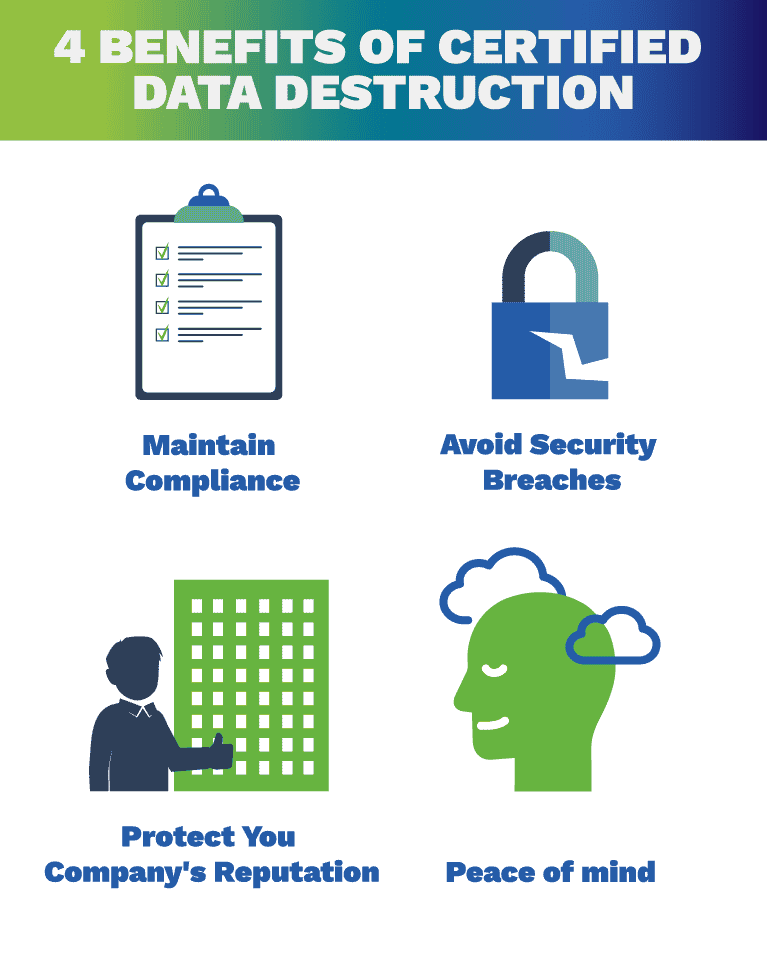The Value of Effective Data Devastation Practices in Safeguarding Sensitive Information and Ensuring Computer System Protection
In an era where data breaches are progressively usual, the significance of efficient information devastation techniques can not be overstated. Organizations face significant dangers when sensitive info is improperly disposed of, potentially leading to unauthorized gain access to and serious economic repercussions. Implementing robust information damage approaches not only alleviates these threats but likewise straightens with legal conformity requirements, making certain that organizations maintain their credibility and foster customer depend on. However, the inquiry stays: what specific methods can be employed to boost these practices, and just how can organizations properly integrate them right into their total cybersecurity structure?
Comprehending Data Damage
Comprehending information destruction is vital in today's electronic landscape, where sensitive info can conveniently be endangered. Reliable information damage involves not merely ensuring but removing files that data is irretrievable through extensive techniques. This process is important for organizations that deal with confidential customer info, copyright, or internal documents, as any type of violation can bring about severe economic and reputational repercussions.
Data destruction includes numerous techniques, including shredding physical media, degaussing magnetic storage tools, and using software-based services that overwrite data multiple times. Each technique offers a certain purpose and should straighten with the level of sensitivity of the information being disposed of. For instance, physical devastation is frequently favored for hard drives having extremely confidential data, while software methods might be enough for less sensitive info.
Moreover, sticking to industry requirements and policies, such as the General Information Defense Guideline (GDPR) or the Health And Wellness Insurance Policy Transportability and Responsibility Act (HIPAA), is critical for compliance and to reduce lawful risks. Organizations has to develop a robust information destruction plan, train staff members on best techniques, and regularly audit their treatments to make sure that all sensitive info is taken care of securely and efficiently.
Dangers of Inadequate Practices
Insufficient information devastation methods subject companies to significant risks that can have far-reaching consequences. When sensitive information is not properly dealt with, it stays at risk to unauthorized gain access to, which can cause information violations and identification theft. Such cases not only endanger the safety of people but also tarnish the company's credibility, causing a loss of client depend on and prospective monetary consequences.
Additionally, regulative conformity is significantly stringent in lots of markets. Failure to abide by information damage regulations can cause large fines and lawsuits versus organizations. These fines can draw away and strain monetary sources attention from core organization operations.
Furthermore, the misuse of recurring information can result in copyright theft or corporate espionage, threatening affordable advantages (data destruction). The effect of inadequate information devastation extends beyond prompt economic losses; it can likewise result in long-lasting damage to brand name stability and market placement

Organizations must recognize that data safety and security is not exclusively concerning protecting against violations; it also includes the accountable monitoring of information throughout its lifecycle. Neglecting efficient data damage protocols can have disastrous effects, highlighting the need for robust actions to alleviate these threats.
Best Practices for Information Destruction
Implementing reliable data devastation methods is vital for guarding sensitive info and maintaining conformity with regulatory standards. Organizations should adopt a multi-faceted strategy to make certain that information is irretrievable, consequently protecting against unapproved gain access to and prospective violations.
First, data ought to be categorized based on level of sensitivity, permitting companies to apply appropriate damage techniques sites tailored to the level of risk. For digital information, using software-based data-wiping tools that follow industry standards can successfully overwrite existing data. Physical damage methods, such as shredding or degaussing, are important for gadgets that store delicate details, ensuring total removal.
Establishing a clear information retention policy is crucial, outlining exactly how long various sorts of information should be retained before devastation. Regular audits of information storage space systems are likewise needed to determine unneeded or obsolete information requiring removal.
Moreover, training staff members on the value of information damage and the particular procedures to adhere to fosters a click to find out more culture of security within the company. Ultimately, keeping documents of information devastation refines gives responsibility and supports conformity with inner policies and external laws. By adhering to these ideal techniques, organizations can considerably reduce the dangers linked with information exposure.
Legal and Compliance Considerations

Failing to follow these policies can result in severe fines, consisting of substantial fines and reputational damage. Organizations needs to carry out a durable information destruction policy that straightens with these lawful frameworks and provides clear standards on the correct methods of information disposal, whether physical shredding or electronic wiping.
Moreover, preserving documents of data devastation activities is necessary for demonstrating conformity during audits or assessments. By focusing on legal and conformity considerations, companies can enhance their information safety and security stance and foster count on with stakeholders and clients, eventually adding to a much more safe information administration environment.
Advantages of Effective Data Destruction
Efficient information damage practices expand past simple compliance; they offer substantial benefits to organizations that prioritize them. By ensuring that sensitive information is irretrievably ruined, organizations alleviate the threat of data breaches and the possible economic repercussions linked with them. This proactive strategy not only safeguards against unapproved accessibility however likewise improves the overall credibility of the company in the eyes of stakeholders and customers.
Applying robust information damage approaches, such as physical destruction of storage space devices or innovative data cleaning methods, contributes to the fortifying of a company's cybersecurity posture. data destruction. It lowers the possibility of copyright theft and safeguards exclusive details, thus maintaining click here for more info a competitive edge in the market

Verdict
Finally, efficient information devastation practices are necessary for safeguarding sensitive details and enhancing general computer system safety. By implementing thorough techniques such as software program, degaussing, and shredding overwriting, organizations can alleviate the threats connected with unauthorized accessibility and data violations. Adherence to regulatory criteria, including GDPR and HIPAA, additional enhances compliance and secures against lawful effects. Ultimately, a dedication to robust data devastation strategies promotes a culture of responsibility, consequently reinforcing a company's cybersecurity posture and maintaining customer trust fund.
